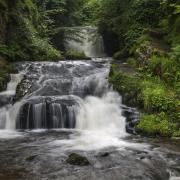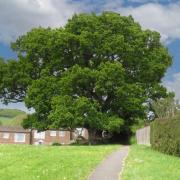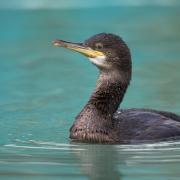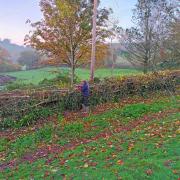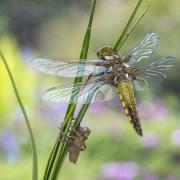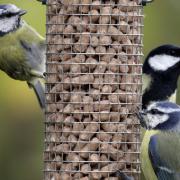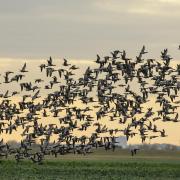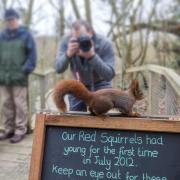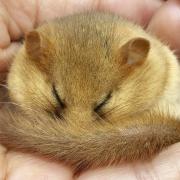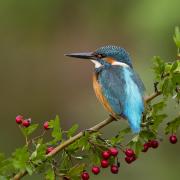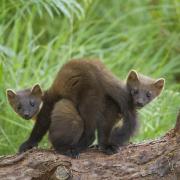A walk along the Exeter Canal can reveal wildlife in droves - even in the most unexpected of places...
Being a keen naturalist, I am usually quite good at using my nose to find promising locations for wildlife watching. Though I use the phrase metaphorically, in the case of the Old Sludge Beds nature reserve it could almost be possible to find it using the nose, since it was once an old sewage farm, near Countess Wear, Exeter.
The Devon Wildlife Trust has some 40 nature reserves around the county, so why choose an old sewage farm to visit? This one is situated on the narrow strip of land between the Exe estuary and the Exeter Canal, so with all that water and mud around there was bound to be some good wildlife.
In the old days, when sewage farms relied upon a series of open settling pools, birds were attracted to them in their droves, and I can remember seeing many rare wading birds, which would have bred in the most remote parts of the Arctic, stopping off at one for a break on their migration. Nowadays, sewage works aren't anywhere near as attractive to birds because of the different processing involved.
These old sludge beds were in use until 1969, when the new treatment works were built adjacent to the reserve. The pools have long reverted to damp marshy ground with willow scrub, and the Devon Wildlife Trust has provided boardwalks so that visitors can sample the reserve's delights without getting wet feet. In fact, the land is not as wet as you might imagine. The soil is very rich and fertile with rushes and reeds the main benefactors, and these dominant species determine the creatures which can be found here.
A great spot for dragonflies
The reserve is managed by rotationally cutting and removing the reeds to prevent a build-up of plant debris which would gradually dry out the wetland. Trees are also felled because they too have a drying effect on the land. Brash piles are left in situ to provide cover for small mammals and birds whilst log piles create a habitat for fungi and insects. This is a great spot for dragonflies in the summer and harvest mice are found here throughout the year. There are also Cetti's warblers, which are resident in the reserve and along the sides of the canal.
Most warblers head off to milder climes in the winter but this species stays and avoids the dangers of migration, although it does run the risk of cold winters. But recent winters have been mild and so it's increasing in number. It's a species that likes reed beds with a good mix of scrub nearby, so this is a really good spot for them. Listen out for its explosive, high-pitched call. Even with its loud voice it's still a frustratingly difficult bird to spot as it tends to stay well hidden.
The sounds of nature have competition here since at the southern end of the reserve is the M5 flyover. However, once beyond this visual monstrosity, a sweeping vista of marsh, estuary and canal open out. To our left is another Devon Wildlife Trust reserve. The Exe reed beds are tidal and need no management to keep them from drying out, but they offer a wonderful sanctuary for birds. Surrounding the reeds are the muddy creeks of the River Exe, to the right the canal provides an artery of quiet freshwater, and beyond that the short grassland of the Exminster marshes stretch off into the distance, broken only by pools of water.
Renowned for its wading birds
Winter is a great time to visit this place because bird life is probably at its most numerous. The Exe estuary is renowned for its wading birds and from the path alongside the canal it should be possible to see avocet, curlew, greenshank, godwits and little egret as well as a good variety of wildfowl including wigeon, red-breasted merganser, brent goose and shelduck. On the canal look for little grebe and cormorant diving for fish. On the Exminster marshes you might see lapwing and golden plover taking flight in large flocks. Hiding away around the rush-fringed pools there will be waders such as the snipe probing the muddy margins and ducks like the teal dabbling at the water's edge.
Timing is important for birdwatching alongside the estuary. At high tide there's little mud so waders retire to roost sites. At low tide birds can be very distant since they often feed along the water's edge, which is sometimes hidden by mud banks. The best time to visit is on a rising tide, a couple of hours before it reaches its maximum height. Don't forget to take a good pair of binoculars.
Spot the sparrowhawk!
Watch the birds' behaviour closely and they may lead you to see things that you might otherwise have missed. In winter, if a flock takes to the air there is always a good reason. Unnecessary flying is costly for the birds in terms of energy, which is why it's essential that dog walkers keep their pets under control. If it isn't a dog or a person spooking them, then it's likely to be a bird of prey. Do you see a fast-moving bird amongst the flock or one soaring overhead? The former could be a sparrowhawk, peregrine or merlin, whilst one overhead could be a buzzard or marsh harrier. Quartering low over the marsh there might be a short-eared owl or, at dusk, a barn owl. Other birds of prey can be seen here at various times of the year and all usually create a fuss amongst the residents.
The climax of the walk is at the end of the canal where there is the Turf pub, www.turfpub.net which reopens after its winter hibernation on 15 March. If you walk the route before then, take your sandwiches.
THROUGH THE SEASONS
SPRING
Occasional garganey stop off on migration on the freshwater pools of the marshes. Whimbrel can be seen in large numbers during April and May.
SUMMER
Reed and sedge warblers return to breed in the reed beds along with the Cetti's warblers which stay here all year. Yellow wagtails can sometimes be found breeding on the freshwater marshes. Breeding waders include small numbers of lapwing and redshank. In late summer swallows and martins gather to roost in the reed beds at dusk. Hunting overhead may be the occasional hobby as well as the inevitable sparrowhawk.
AUTUMN
At this time of year wading bird residents are boosted by migrant species. This is the time to see sandpipers including the common and green varieties. You may spot little stint or curlew sandpiper in amongst the commoner species on the mud flats. This is also the best time for catching up with a passing osprey.
WINTER
The best season for large numbers of wading birds and wildfowl. On the marshes look for teal, wigeon, shoveler, snipe, lapwing and golden plover. More frequently seen on the mud of the estuary are brent geese, shelduck, curlew, black-tailed godwit, avocet, dunlin, redshank, greenshank and spotted redshank. The canal and river play host to red-breasted merganser, goldeneye and occasional rarer species such as goosander, smew, divers and grebes. In cold weather watch out for other species of geese and wintering swans (Bewick's or whoopers). Birds of prey can include kestrel, sparrowhawk, merlin, peregrine, marsh harrier, hen harrier, short-eared owl and barn owl.
FACT FILE
The nearest place to park is in the University boat house on the south side of the A379 between where it passes over the River Exe and the Exeter Canal, at OS grid ref 941894. From here it is a short walk along the minor road past the current sewage works to the Old Sludge Beds reserve at OS grid ref 950889.
Continuing past the reserve, the towpath on this side of the canal is not as well surfaced as it is on the other (wear boots), but it has better views over the estuary. You can cross the canal opposite Topsham and also at the Turf pub at the end of the canal. Walk back on the other side of the canal and you have good views over the Exminster marshes. The return walk to the Turf pub is nearly six miles and will take about three hours.
DAVID CHAPMAN



